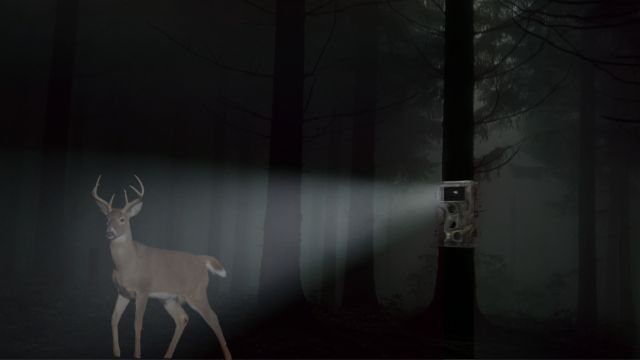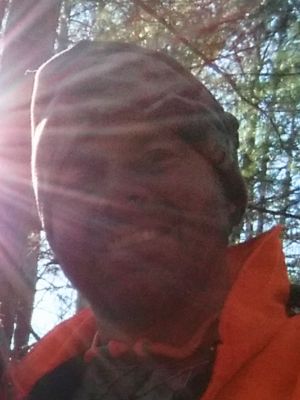
Trail cameras have revolutionized wildlife monitoring, allowing us to capture stunning images and videos of animals in their natural habitats. These cameras have become increasingly popular among hunters, wildlife enthusiasts, and property owners alike. However, one aspect of these cameras that many users are unsure about is whether trail cameras flash at night.
In this article, we will explore the different types of flash used on trail cameras. We will examine if these different types of flash are visible flash when in use, and whether or not they are detectable by deer.
Table of Contents
Do Trail Cameras Flash at Night?
If your trail camera is capturing pictures or videos in low light conditions it is absolutely using a flash.
Whether or not the flash on a trail camera is visible to the naked eye is the real question. The answer to that depends on the type of trail camera you are using. More specifically, it depends on the type of flash a trail camera uses.
So let’s look at the different types of flash in more detail.
Types of Trail Camera Flash
There are three main types of trail camera flash: white flash, low glow flash, and no glow flash.
White Flash
When a camera that is equipped with “white flash” is triggered at night, it emits a bright white light, as you would expect with traditional flash photography or a DSLR camera, which illuminates the area in front of the camera and results in the trail camera being able to capture detailed full-color images. Depending on the specific camera, the white flash is created from either a xenon strobe or an LED flash.
White flash cameras generally produce higher quality images and videos with more detail than their low glow or no glow counterparts. However, the bright burst of light is easily visible to the naked eye and will give away the camera’s location at night, which might make it less than ideal for situations where you want to keep the camera’s location hidden at night. This flash can startle animals and potentially scare them away, or cause them to change their behavior and avoid the area altogether, making it less ideal for wildlife monitoring in sensitive areas.
Several years ago when I bought my first trail camera, a white flash was the only option available for those who wanted a trail camera that could get pictures of game at night. These days, with the advent of infrared flash, white flash cameras are becoming increasingly hard to find as more and more people are gravitating toward cameras with low glow and no glow flash, as they do a better job of keeping their location concealed in low light conditions. That said, trail cameras with white flash have their place, especially for researchers or photographers who need detailed, color images and videos of animals at night.
Low Glow Flash
Trail cameras with “low glow” flash, also referred to as infrared or red glow flash, use LEDs that emit infrared light at a wavelength of 850nm to illuminate the area the camera is monitoring. Cameras with low glow flash typically produce black-and-white pictures and videos in low-light or nighttime conditions. This is because the camera’s sensor is set up to capture images in darkness or low light conditions using the infrared light emitted by the low glow flash.
Despite the lack of color, the images and pictures captured using low glow flash still contain an amazing amount of detail. Plus, the low glow flash doesn’t visibly illuminate the area in front of the camera as a white flash does because the 850nm infrared light that is emitted from the LEDs is outside the portion of the electromagnetic spectrum that is visible to the human eye, which for most people is around 380 to 750 nanometers. However, if you look at the front of the trail camera with a low glow flash at the exact moment the flash is in use you will notice that the LEDs give off a dim red glow, which can reveal the camera’s location at night. This glow is visible to both humans as well as many animals but it is much less likely to startle animals or make them change their behavior.
It’s worth noting that some newer trail cameras with low glow flash may have advanced sensors or additional features that allow them to capture color images and videos in low-light conditions (not complete darkness). However, black and white images and videos are still the most common result when using low glow flash in trail cameras for nighttime monitoring.
When infrared flash first started to appear in trail cameras, low glow flash was the technology that was used. In fact, my first trail camera with infrared flash was a low glow model and I thought it was amazing. Low glow flash strikes a great compromise between stealthiness, helping to keep the trail camera hidden at night, and image quality. In addition, it has a long flash range and manufacturers are able to put it on trail cameras while allowing them to keep the cost of the camera low.
Low glow flash is probably the most popular or common flash currently available for trail cameras. That said, no glow flash, which we will talk about next, is my favorite.
No Glow Flash
Similar to low glow flash trail cameras, trail cameras equipped with no glow flash (also known as Black Flash, Invisible Flash, or Black Out flash) emit infrared light, but the LEDs used by the no glow flash emit infrared light with a wavelength of 940nm. Trail cameras with no glow flash will capture black-and-white pictures and videos during low-light or nighttime conditions. As mentioned in our discussion of low glow flash, this is because the camera’s sensor is set up to capture images in darkness or low light conditions using the light emitted by infrared LEDs.
As with the low glow flash, the pictures and videos captured using no glow flash lack a certain amount of detail due to their lack of color. Another way in which no glow flash is similar to low glow flash is that the no glow flash doesn’t visibly illuminate the area in front of the camera because the infrared light that is emitted from the LEDs is beyond the portion of the electromagnetic spectrum that is visible to humans, which is approximately 380 to 750 nanometers.
The big advantage no glow trail cameras have over low glow trail cameras is that even if you look directly at the front of the trail camera when the flash is in use, the LEDs on the front of the camera don’t give off any visible light. In other words, because 940nm infrared light is further away from the visible light spectrum, cameras with no glow flash don’t reveal their location at night the way low glow trail cameras do and are less likely to disturb animals.
Despite their advantages, trail cameras with no glow flash do have some shortcomings. The flash range of no glow cameras is typically shorter than that of their low glow counterparts and these cameras are also priced a bit higher. That said, no glow flash trail cameras are becoming increasingly popular for their stealth capabilities, which gives them the versatility to used for hunting on both private and public land, as well as for security purposes.
Can Deer See a Trail Camera Flash?
Research tells us that deer have different visual capabilities than humans. They can see in low light conditions better than humans, but they have poorer color vision. They can see short (blue) and middle (green) wavelength colors well, with their vision being most sensitive to wavelengths around 430nm. However, they are less sensitive to colors with longer wavelengths such as red and orange.
Another thing we know is that ungulates, which includes deer, are able to detect light many times below our threshold in the blue and UV wavelengths. However, the good news for trail camera users is that deer struggle to see infrared light, which is beyond the orange and red light on the electromagnetic spectrum.
So what does this mean as it relates to deer being able to see the flash from a trail camera:
White light contains all the wavelengths of the visible spectrum. So when the flash goes off on a camera with a white flash deer it will definitely be noticed by deer not only when they look at the front of the camera, but also when they look at the area that the flash is illuminating as well.
Since deer struggle to see infrared light, it is significantly less likely that they will notice a trail camera that uses low glow flash. That said, many people believe that deer will notice the LEDs glowing red if they are looking directly at the camera when the flash is in use. As for myself, I have seen instances with my low glow trail camera where it appears that the deer have noticed the red glow on the front of the camera, but it could also be that they were curious about something that was nearby the camera (it is impossible for me to prove either way).
As far as no glow flash is concerned, the 940nm infrared LEDs used in a no glow flash emit light that is even further away from the visible light portion of the electromagnetic spectrum than what the LEDs on a low glow flash emit. This type of flash is invisible to both humans and deer.
Final Thoughts
While every trail camera that is set to take pictures or record video at night uses a flash, there is a range of flash options available, each with its own unique blend of performance and stealthiness. Whether you opt for a camera with white, low glow, or no glow flash, by understanding the different types of trail camera flash and how they work, you can select the right camera for your needs and maximize your chances of capturing high-quality images.


